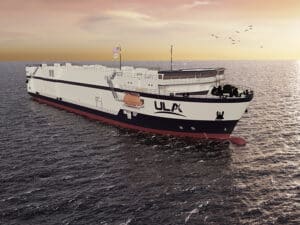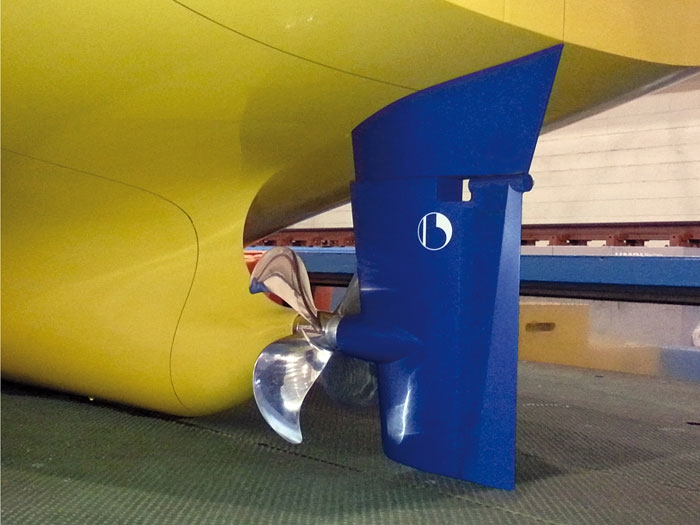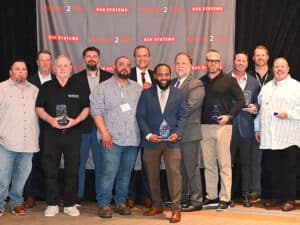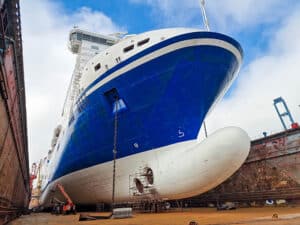
Becker Cross Over Rudder promises major fuel savings
Written by Nick Blenkey
Cross Over Rudder model prepared for performance test at Korean model test facility
MARCH 25, 2014 — Although the inflow to the ship’s rudder area is mostly unfavorable to hydrodynamic efficiency, Becker Marine Systems, Hamburg, Germany, has developed a high-tech Cross Over Rudder that converts the swirl in the area into driving power.
Optimization between the propeller hub cap and rudder is performed by a rudder bulb, creating an energy-efficient solution that maintains optimum maneuverability.
Specifically designed for stern optimization, the Cross Over Rudder complements the Becker Mewis Duct and Becker Twisted Fin.
“Our customers have realized that a great deal of energy can already be saved in front of the propeller through the use of the Becker Mewis Duct and Becker Twisted Fin,” says Dirk Lehmann, Managing Director of Becker Marine Systems. “This is now possible on the rudder, too. If the three systems of the stern, propeller and rudder unit are perfectly matched with one another, energy consumption can be lowered in a double-digit percentage range.”

CFD simulation of energy losses in the water flow without rudder bulb
“We are working together with all leading model research institutes across the world to further improve efficiency below the waterline,” says Sales Manager Walther Bauer. “We perform approximately 100 model tests every year and have gained a lot of valuable experience in this area.”
He says this experience enables Becker Marine Systems to offer “a neutral position of expertise” in regard to the optimization of propulsion and maneuvering systems.
 Becker is actively working on “Green Shipping” initiatives since hydrodynamic energy conservation plays a prominent role in its products.
Becker is actively working on “Green Shipping” initiatives since hydrodynamic energy conservation plays a prominent role in its products.
Same CFD simulation with rudder bulb, showing reduced energy losses
“Thanks to flow simulations using Computational Fluid Dynamics (CFD), complete ships including cargo, propeller design and rudder can be calculated,” says Mr. Lehmann. “Becker Marine Systems is able to optimize the propeller and rudder part of this. Consequently, for shipyards and shipowners we are a competent partner for ship conversions as well as newbuildings.”
Not all shipping companies are taking advantage of the potential savings.
Mr. Bauer notes that substantial percentages of efficiency are still being lost because some shipping companies continue to buy just a rudder and not take the overall system into consideration and propellers are often being sold without performance optimization.
“This is where the opportunity to save money while protecting the environment is being squandered,” he says.
Becker Marine Systems can perform an overall optimization of the propeller hub cap and rudder bulb, independent from the propeller manufacturer.
“Through our close collaboration with leading engine manufacturers such as MAN and Wärtsilä we are able to design complete drive propulsion systems along with maneuvering systems,” says Mr. Lehmann. “For both companies we have also developed a rudder matching their specific propeller.”
The Cross Over Rudder is particularly worthwhile for fast ships with a high propeller loads, such as ferries, container and passenger ships. For these ships, says Mr. Bauer, the cost savings are so large that the return on investment is usually achieved within one year.
A retrofitting may often also be worthwhile. If ships have completely changed their operating profile, this may involve rebuilding the propellers.
“In such retrofitting solutions,” says Mr. Lehmann, “we offer to perform a CFD analysis of the rudder and propeller, which can then be adjusted accordingly. Unlike our competitors, we can perform these optimizations for each shipping company and shipyard independently from the propeller manufacturer.”
Becker Marine Systems currently has orders for high-performance rudders for vessels that include five 14,000 TEU containerships under construction at Hyundai Heavy Industries, five 18,800 TEU containerships for the United Arab Shipping Company (UASC) and seven 8,800 TEU containerships on order for China International Marine Containers (CIMC) at Dalian Shipbuilding that are being chartered by the Mediterranean Shipping Company (MSC). In cooperation with Wärtsilä, the company is also involved with a series of new ConRo ships for the Grimaldi Group.
“The Cross Over Rudder systems are in such high demand that they may take a 20 to 30 percent share of incoming orders in the coming years,” says Mr. Lehmann. “They could thus become a product as successful as the Mewis Duct, 580 units of which we have already sold. The resonance from shipowners continues to be very positive – and more than 530,000 tonnes of CO2 could be reduced overall.”





Leave a Reply
You must be logged in to post a comment.